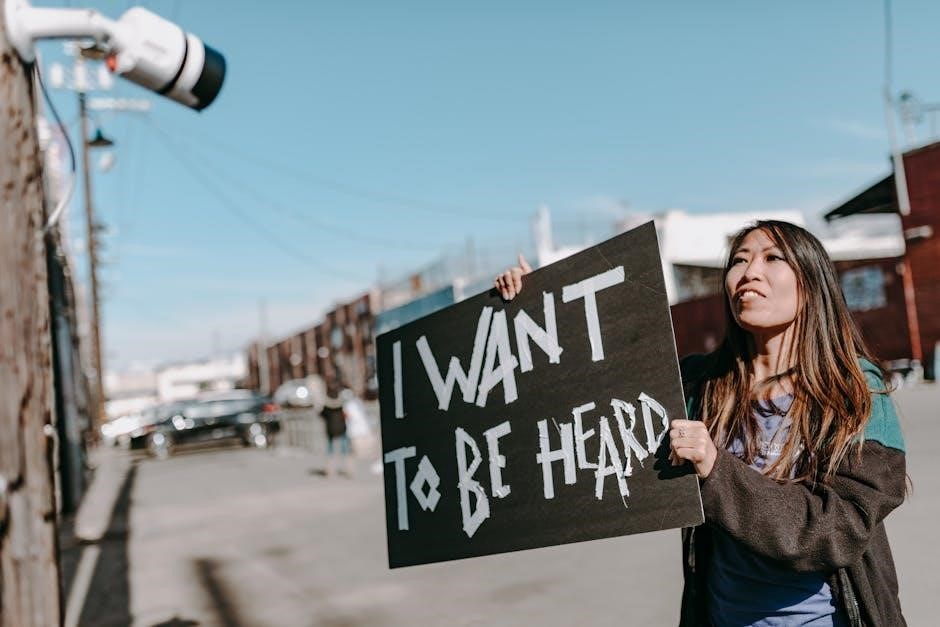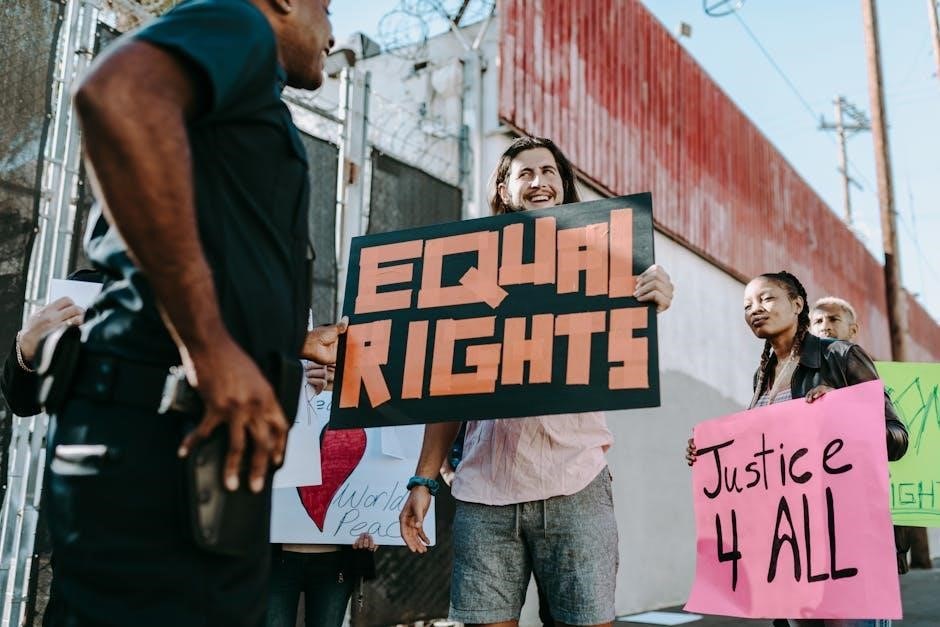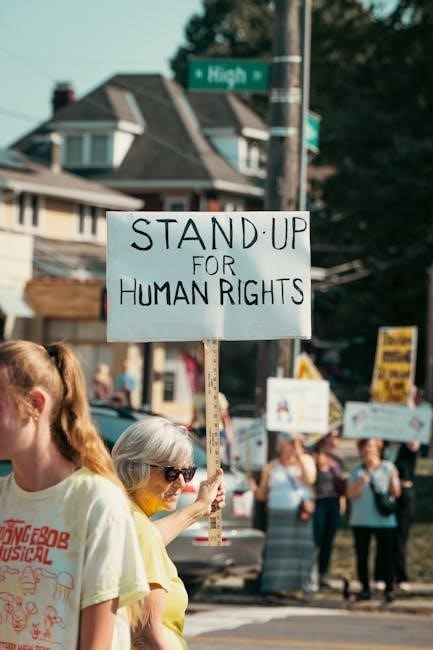The text explores the dynamic field of criminal justice, emphasizing diversity, change, and real-life case studies to illustrate system processes and ethical challenges.
Overview of the Criminal Justice System
The criminal justice system is a network of institutions, policies, and practices designed to maintain social order, enforce laws, and deliver justice. It comprises law enforcement, courts, and corrections, working interdependently to address crime and rehabilitation. The system’s effectiveness is influenced by diversity, change, and ethical considerations, ensuring fair treatment for all individuals. Understanding its structure and functions is crucial for addressing contemporary challenges and promoting equitable justice.
Importance of Understanding Diversity and Change
Understanding diversity and change is essential for addressing biases and ensuring equitable justice. The criminal justice system must adapt to societal shifts, such as evolving demographics and technological advancements. Recognizing diversity helps in addressing disparities faced by marginalized groups, promoting fairness and inclusion. Change fosters innovation, enabling the system to respond effectively to emerging challenges. By embracing these principles, the criminal justice system can better serve all individuals, ensuring ethical practices and equitable outcomes for a diverse society.
Structure of the Criminal Justice System
The criminal justice system is structured into three primary components: law enforcement, courts, and corrections. Law enforcement agencies investigate crimes and apprehend suspects. Courts adjudicate cases, determining guilt and imposing sentences. Corrections manage offenders through incarceration, probation, or parole. This interconnected framework ensures accountability, justice, and rehabilitation. Each component plays a vital role in maintaining public safety and upholding legal standards, working collaboratively to address criminal behavior and protect society.

Historical Perspectives in Criminal Justice
Understanding the evolution of criminal justice systems reveals foundational changes in laws, policing, courts, and corrections, shaping modern practices and addressing societal needs over time.
Evolution of Law Enforcement
The evolution of law enforcement reflects societal changes, from informal community watch systems to modern professional policing. Historical developments include the establishment of formal police forces, advancements in training, and the adoption of technology. Contemporary strategies emphasize community-oriented policing, diversity, and ethical practices. The integration of technology, such as surveillance and data analytics, has transformed law enforcement operations. These changes highlight the adaptability of law enforcement in addressing emerging challenges and promoting public safety. Understanding this evolution provides insight into the complex role of policing in criminal justice systems.
Development of Courts and Judiciary
The development of courts and judiciary systems has been shaped by historical, legal, and societal factors. Early court systems focused on resolving disputes and upholding laws, evolving into more structured judicial bodies. Key milestones include the establishment of independent judiciaries and the adoption of due process principles. Modern courts incorporate technological advancements and diversity initiatives to ensure fair representation. The judiciary plays a critical role in interpreting laws, protecting rights, and maintaining justice. This evolution reflects the dynamic nature of legal systems in addressing societal needs and upholding the rule of law.

History of Corrections and Punishment
The history of corrections and punishment reflects societal values and evolving approaches to crime management. Early systems emphasized retribution, with practices like public executions and physical punishments. The rise of the penitentiary in the 18th century introduced solitary confinement and hard labor as forms of rehabilitation. Over time, corrections shifted toward rehabilitation, with the development of parole systems and prison reforms. Modern corrections balance punishment with rehabilitation, incorporating counseling, education, and technology to prepare offenders for reintegration into society while addressing systemic challenges and ethical concerns.

Contemporary Issues in Criminal Justice
Modern criminal justice faces challenges like police reform, racial disparities, and technological impacts, requiring adaptive strategies to ensure fairness and efficiency in a diverse society.
Current Challenges in Law Enforcement
Law enforcement faces significant challenges, including racial disparities, use-of-force controversies, and technological advancements. Police reform efforts aim to enhance accountability and transparency, addressing public trust issues. Officers must navigate complex societal dynamics, balancing safety with community relations. Technological tools, while aiding investigations, also raise privacy concerns. Training programs are evolving to address implicit bias and de-escalation techniques. Additionally, resource allocation and mental health support for officers are critical areas needing attention to ensure effective and equitable law enforcement practices in a diverse and changing society.
Modern Court Systems and Practices
Modern court systems emphasize efficiency, transparency, and fairness, integrating technology to streamline processes. Virtual hearings and digital evidence management are now common, enhancing accessibility. Courts also prioritize diversity, ensuring judicial representation reflects societal demographics. Alternative dispute resolution methods, like mediation, reduce caseloads. Data-driven analytics improve decision-making, while public access to court records fosters accountability. These advancements aim to address systemic biases and improve outcomes for all parties involved, ensuring justice is served equitably in a rapidly evolving legal landscape.
Contemporary Corrections and Rehabilitation
Contemporary corrections focus on rehabilitation over punishment, emphasizing restorative justice and offender reintegration. Technology, such as electronic monitoring, enhances supervision and safety. Mental health and substance abuse treatment are prioritized to address underlying issues. Educational and vocational programs prepare inmates for post-release success. Diversity and cultural sensitivity are integrated into correctional practices to ensure equitable treatment. These approaches aim to reduce recidivism and promote community safety while addressing the complex needs of offenders in a humane and effective manner.
Diversity in the Criminal Justice System
Understanding diversity is crucial for equitable criminal justice practices, addressing gender, racial, and socioeconomic disparities to ensure fair treatment and representation within the system.
Gender Diversity in Criminal Justice
Gender diversity in criminal justice addresses disparities in treatment and representation, focusing on the unique experiences of women as offenders, victims, and professionals. Historical biases have often marginalized female perspectives, but modern reforms aim to promote equity. Understanding gender dynamics is essential for fair policies and practices. Education and awareness are key to breaking stereotypes and fostering inclusivity within the system. This ensures that gender diversity is recognized and respected at all levels of criminal justice administration.
Racial and Ethnic Diversity in the System
Racial and ethnic diversity within the criminal justice system highlights systemic disparities and biases affecting marginalized communities. Historical and contemporary data show overrepresentation of minorities in arrests, convictions, and sentencing. Addressing these issues requires policy reforms, cultural competence, and community engagement. Understanding the intersection of race, ethnicity, and justice is crucial for creating equitable outcomes. Education and advocacy are vital to dismantling systemic racism and fostering a fairer criminal justice system that respects and serves all populations equally.
Socioeconomic Factors and Criminal Justice
Socioeconomic factors significantly influence interactions with the criminal justice system, as poverty, education, and employment opportunities shape outcomes. Individuals from disadvantaged backgrounds often face limited access to legal resources, leading to disparities in representation and sentencing. Economic inequality exacerbates systemic biases, with marginalized groups more likely to experience criminalization. Addressing these issues requires comprehensive reforms and community-based initiatives to ensure equitable treatment and reduce recidivism. Understanding the interplay between socioeconomic status and justice is essential for fostering a fairer system that supports all individuals, regardless of their background.

Technology and Criminal Justice
Technology enhances criminal justice operations through surveillance, data analysis, and monitoring tools, improving efficiency and transparency while addressing ethical concerns in modern law enforcement and corrections.
Role of Technology in Law Enforcement
Technology has revolutionized law enforcement, enhancing efficiency and transparency. Tools like body-worn cameras and facial recognition software aid in evidence collection and suspect identification. Data analytics predict crime patterns, enabling proactive policing. Digital forensics analyze evidence, while communication systems improve response times. However, ethical concerns arise, such as privacy violations and algorithmic bias. These advancements balance public safety with accountability, ensuring modern policing adapts to evolving challenges while maintaining trust and integrity in law enforcement practices.
Technological Advancements in Courts
Technological advancements in courts have streamlined legal processes, enhancing efficiency and accessibility. Virtual hearings and digital evidence management systems reduce delays and improve transparency. AI tools assist in case analysis, predicting outcomes and identifying patterns. Electronic filing systems simplify document management, while court analytics provide insights for better decision-making. These innovations ensure consistency and fairness, modernizing the judiciary’s role in the criminal justice system. They also address diversity by providing equal access to legal resources, fostering a more inclusive and adaptive court environment.
Technology in Corrections and Monitoring
Technology in corrections and monitoring has revolutionized the management of offenders, enhancing efficiency and safety. Electronic monitoring systems track parolees in real-time, reducing recidivism risks. Biometric identification ensures accurate inmate tracking, while AI predicts potential security threats. Digital platforms facilitate rehabilitation through virtual counseling and education. These tools improve oversight, reduce costs, and promote offender reintegration. They also address diversity by providing tailored programs, ensuring equitable treatment regardless of background. Technology thus modernizes corrections, balancing punishment with rehabilitation in a fair and transparent manner.

Victimization and the Criminal Justice System
Victimization profoundly impacts individuals and society, necessitating robust support systems. Understanding its effects and addressing diversity in victim experiences is crucial for equitable justice and recovery.
Understanding Victimology
Victimology examines the nature, extent, and impact of victimization, focusing on victims’ experiences, rights, and interactions with the criminal justice system. It explores factors influencing victimization, such as demographics, socioeconomic status, and systemic inequalities. By understanding these dynamics, victimology aims to improve support systems, enhance justice outcomes, and reduce revictimization. This field emphasizes the importance of addressing diversity in victim experiences to ensure equitable treatment and resources for all individuals affected by crime.
Impact of Victimization on Individuals and Society
Victimization profoundly affects individuals, causing emotional trauma, financial loss, and long-term psychological distress. It can lead to diminished trust in institutions and social withdrawal. Societal impacts include increased fear of crime, strained community relations, and economic burdens from healthcare and legal costs. Addressing victimization is crucial to fostering resilience, reducing recidivism, and promoting collective well-being. Understanding these effects highlights the need for supportive systems and policies to mitigate harm and rebuild lives.
Support Systems for Victims
Effective support systems for victims are essential to aid recovery and rebuild lives. These include counseling services, legal aid, and advocacy programs tailored to individual needs. Hotlines, shelters, and community resources provide immediate assistance, while victim compensation programs help alleviate financial burdens. Educational initiatives and public awareness campaigns also play a role in reducing stigma and promoting understanding. Collaborative efforts between law enforcement, social services, and non-profits ensure comprehensive support, fostering resilience and empowering victims to heal and reintegrate into society successfully.

Life After Incarceration
Life after incarceration involves challenges such as reintegrating into society, securing employment, and overcoming stigma. Support systems and reentry programs are crucial for successful rehabilitation and reintegration.
Parole and Reentry Programs
Parole and reentry programs are designed to assist individuals transitioning from incarceration back into society. These programs aim to reduce recidivism by providing support such as counseling, job training, and housing assistance. They often include supervision and monitoring to ensure compliance with parole conditions. Effective reentry programs address the unique needs of offenders, helping them reintegrate successfully. Challenges include limited resources, stigma, and societal barriers. Successful reentry requires collaboration between criminal justice agencies, community organizations, and individuals to foster rehabilitation and public safety. These programs are critical for breaking the cycle of crime and rebuilding lives.
Challenges Faced by Ex-Offenders
Ex-offenders face significant challenges upon reentering society, including societal stigma, employment discrimination, and limited access to housing. Many struggle with mental health issues and substance abuse, exacerbated by inadequate support systems. Legal barriers, such as felony disenfranchisement and restricted professional licensing, further hinder their ability to reintegrate. These challenges often lead to recidivism, highlighting the need for comprehensive reform and community support to address systemic inequities and promote successful reintegration into society.
Reintegration into Society
Reintegration into society is a critical phase for ex-offenders, requiring access to education, job training, and mental health services. Mentorship programs and community support systems play a vital role in helping individuals rebuild their lives. Addressing systemic barriers, such as housing and employment discrimination, is essential for successful reintegration. By fostering inclusivity and providing resources, society can reduce recidivism and empower ex-offenders to contribute positively. This process underscores the need for ethical criminal justice reforms that prioritize rehabilitation and community well-being.
Ethics and Policy in Criminal Justice
Ethics and policy in criminal justice address moral dilemmas, reforms, and systemic fairness. They ensure equitable treatment, accountability, and transparency, shaping a just and evolving legal framework.
Ethical Dilemmas in Law Enforcement
Law enforcement faces ethical dilemmas such as use of force, racial profiling, and corruption. These issues challenge officers’ judgment and integrity, impacting public trust and systemic fairness. Addressing these dilemmas requires robust training, accountability, and transparent oversight to ensure ethical practices and uphold justice. The integration of diversity and change in policing strategies further emphasizes the need for ethical standards to foster trust and collaboration between law enforcement and the communities they serve.
Ethical Considerations in the Courts
Ethical considerations in courts involve ensuring fairness, impartiality, and transparency in legal proceedings. Judges and court officials must navigate issues like bias, conflicts of interest, and privacy concerns. The integration of diversity and change in court practices highlights the need for culturally sensitive decision-making and equal access to justice. Ethical dilemmas often arise in sentencing, evidence handling, and jury selection, requiring a balanced approach to uphold the integrity of the legal system and protect the rights of all individuals involved.
Ethical Issues in Corrections
Ethical issues in corrections often revolve around balancing punishment, rehabilitation, and human rights. Overcrowding, poor living conditions, and solitary confinement raise concerns about dignity and mental health. Diversity and systemic biases can lead to disproportionate treatment of marginalized groups. Technological advancements, like surveillance, bring privacy concerns. Ensuring ethical practices requires addressing these challenges while prioritizing rehabilitation and reintegration, ultimately aiming to create a fair and humane correctional system that respects individual rights and promotes societal safety.
Global Perspectives on Criminal Justice

Global perspectives on criminal justice reveal diverse approaches to crime and punishment, emphasizing collaboration and human rights across international systems and cultural contexts.
Comparative Criminal Justice Systems
Comparative criminal justice systems analyze differences in legal frameworks, law enforcement, and corrections across nations. This approach highlights diverse strategies for crime reduction, punishment, and rehabilitation, emphasizing cultural, historical, and societal influences. By examining global trends, such as the use of technology and restorative justice, scholars identify best practices and challenges. Understanding these systems fosters collaboration and reform, addressing shared issues like human rights and systemic inequality. This comparative lens provides insights into the complexities of justice worldwide, promoting a more equitable and effective global approach to criminal justice.
International Approaches to Criminal Justice
International approaches to criminal justice vary widely, reflecting diverse legal frameworks, cultural norms, and societal values. Many nations emphasize restorative justice, focusing on rehabilitation over punishment, while others prioritize deterrence through strict penalties. Global cooperation addresses transnational crimes like human trafficking and cybercrime. The U.S. system, for instance, contrasts with Scandinavian models that prioritize rehabilitation. Understanding these differences fosters cross-border collaboration and informs domestic reforms. This global perspective highlights the importance of cultural sensitivity and human rights in shaping criminal justice practices worldwide.
Global Challenges and Collaborations
Global criminal justice faces challenges like transnational crime, human rights violations, and resource disparities. Cybercrime and human trafficking require international cooperation. Collaborative efforts, such as Interpol initiatives, enhance cross-border law enforcement. Technology aids in sharing intelligence and combating organized crime. Global partnerships also address systemic issues like corruption and inequality. These collaborations foster innovation and mutual understanding, ensuring a more equitable and effective global criminal justice system. International frameworks emphasize human rights and sustainable development, promoting justice worldwide.

Case Studies in Criminal Justice
Case studies provide real-life examples, illustrating the criminal justice process and its impact on individuals and society, making complex concepts engaging and relatable.
Real-Life Examples of Criminal Cases
Real-life examples of criminal cases provide a practical understanding of the justice system’s operations. These cases, often highlighted in textbooks, illustrate how crimes are processed from investigation to sentencing. They reveal the complexities of legal procedures, the roles of law enforcement, courts, and corrections, and the ethical dilemmas faced by professionals. By examining actual scenarios, students can connect theoretical concepts to real-world applications, gaining insight into the human impact of criminal justice decisions and the broader societal implications of crime and punishment.
Analysis of Case Studies
Case studies provide in-depth examinations of criminal justice processes, offering insights into the system’s dynamics. By analyzing real-life scenarios, students can identify how legal frameworks, law enforcement practices, and societal factors influence outcomes. These analyses highlight ethical dilemmas, systemic biases, and the human impact of decisions within the justice system. They also reveal the interconnectedness of criminal justice components, such as policing, courts, and corrections, and their roles in upholding justice and promoting societal change.
Lessons Learned from Case Studies
Case studies offer valuable lessons on the criminal justice system’s complexities, revealing systemic issues, ethical dilemmas, and the impact of diversity. They highlight the importance of fairness, accountability, and reform. By examining real-life scenarios, students gain insights into how policies and practices shape outcomes for offenders and victims. These lessons emphasize the need for empathy, critical thinking, and evidence-based approaches to address inequalities and improve the system’s effectiveness in delivering justice and promoting societal well-being.
The criminal justice system must adapt to societal changes, embracing diversity and ethical reforms. Future directions include integrating technology and prioritizing rehabilitation for a fairer justice system.
Summarizing Key Concepts
The criminal justice system is a complex, evolving field shaped by diversity and societal changes. It encompasses law enforcement, courts, and corrections, each interconnected and influenced by ethical, policy, and technological advancements. Understanding this system requires examining its historical roots, contemporary challenges, and future trends. Key concepts include the role of diversity, victimization, and rehabilitation, as well as the need for reform and adaptation to ensure fairness and justice. Real-life case studies and critical analyses provide insights into the system’s dynamics and its impact on individuals and society.
Future Trends in Criminal Justice
Future trends in criminal justice emphasize technology integration, diversity, and rehabilitation. Advances in data analytics and AI will enhance decision-making and transparency. Restorative justice and community-based programs will gain prominence, focusing on rehabilitation over punishment. Mental health and substance abuse interventions will be prioritized. Ethical considerations, such as bias reduction, will shape policies. Global collaborations will address cross-border crimes. These trends aim to create a more equitable and effective system, adapting to societal changes and technological advancements while ensuring justice for all.
Call to Action for Reform and Improvement
A call to action for criminal justice reform emphasizes addressing systemic inequities, promoting diversity, and leveraging technology for transparency. Stakeholders must advocate for policies that reduce bias, improve rehabilitation programs, and enhance community trust. Education and training on ethical practices are crucial. By fostering collaboration between law enforcement, courts, and communities, meaningful change can be achieved. Proactive measures, such as implementing restorative justice and mental health interventions, are essential for creating a fairer system. Collective effort is vital to ensure justice for all and drive sustainable improvement.

Additional Resources
by Callie Marie Rennison and Mary Dodge for comprehensive study materials.
Recommended Reading and References
by Callie Marie Rennison and Mary Dodge, available as a free PDF. Supplementary materials like test banks and study guides enhance understanding. Online platforms offer downloadable resources, while academic databases provide access to related research articles and case studies. These references ensure a comprehensive exploration of criminal justice systems, diversity, and reform efforts, supporting both students and researchers in their studies.
Online Resources and Tools
textbook and supplementary materials online. Free PDF downloads are available through academic platforms and repositories. Test banks, study guides, and interactive eBooks enhance learning. Websites like ResearchGate and SAGE Publications offer additional resources, including case studies and research articles. Online forums and educational tools provide further insights, making it easier to explore criminal justice systems, diversity, and reform efforts from anywhere, at any time.
Further Study and Research Opportunities
PDF for in-depth insights. Delve into topics like ethics, diversity, and technological advancements. Engage with case studies and real-life examples to deepen understanding. Utilize academic platforms and interactive tools for enhanced learning. Consider enrolling in specialized courses or attending webinars for advanced knowledge. Join online forums and research communities to discuss emerging trends and collaborate on projects, fostering a comprehensive understanding of criminal justice systems and their evolving nature.
